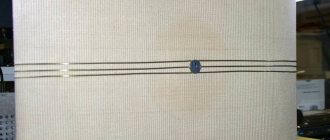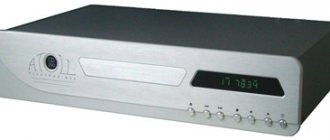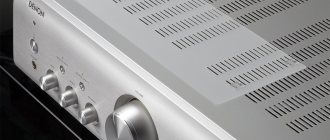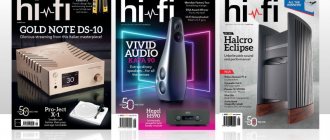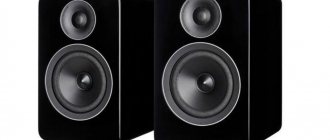CD player + Denon integrated amplifier and HECO speakers
In this section, we usually consider expensive systems that claim to belong to the audiophile elite. This time, I was interested in the kit shown at the recent Hi-Fi & High End Show 2014 - despite the far from ideal listening conditions and the modest price for these times, the combination of Denon and HECO left few people indifferent.
SYSTEM
- CD player Denon DCD-1520AE (RUB 59,990)
- Integrated amplifier Denon PMA-1520AE (RUB 59,990)
- Speaker systems HECO Aleva GT 1002 (RUB 59,990/pair)
- Cables: — interconnect In-Akustik Referenz NF-1603 RCA 1 m (RUB 33,990)
- — acoustic In-Akustik Referenz LS-1603 BFA Banana 2 x 3 m (RUB 82,990)
It is curious that all the components that we are going to listen to - a source, an amplifier and a pair of speakers - are announced at the same price, 59,990 rubles. The only exception will be cables. To fully exploit the musical capabilities of the system, In-Akustik products from the top Referenz Selection line were used, which amounted to about a quarter of the project cost. However, as earlier studies have shown*, the overall sound character will remain the same with more affordable cables in this series. We will return to them later, but we will begin, according to tradition, with a brief description of the main components of the system.
The Denon DCD-1520AE player plays CDs and SACDs, which is a big plus. Among the features, I would like to note the proprietary SVH (Suppresses Vibration, Hybrid) drive with powerful vibration protection, as well as an advanced 32-bit DAC running on the AL32 algorithm. The device is ready for use as an external converter, since it has a full set of digital inputs - optical, coaxial and asynchronous USB, capable of receiving digital data from a PC in formats up to 24 bit/192 kHz. The remaining inputs can decode PCM and DSD 2.8/5.6 MHz streams. Another USB connector on the front panel is designed for connecting iPhone/iPod and portable media with WMA, mp3 and WAV files with resolutions up to 16/48. There is also a headphone jack on the front, the signal to which is supplied from a high-quality telephone amplifier.
Among the external features, I would like to note a thin loader tray, invisible when closed, and a display, the brightness of which, down to zero, can be adjusted from the remote control. When playing an SACD, text information is displayed in a creeping line.
From a design point of view, the Denon PMA-1520AE integrated amplifier can serve as an example of minimalism. The large volume knob in the center is visually highlighted by the input selector on the right and tone/balance controls on the left. There is also a 6.3 mm jack for stereo phones and two buttons - Power Amp Direct and Source Direct. The first turns the amplifier into a “pure” end without a preliminary part (for example, for working together with an AV processor), and the second runs the signal bypassing the switch and tone control unit. The architecture provides for the connection of additional devices between the preliminary and final stages.
The amplifier is designed for five linear signal sources and one analog recorder. I would especially note the presence of a high-quality phono preamplifier, capable of working with MM and MC heads.
The power of the PMA-1520AE is quite sufficient for the average living room - 2 x 70 W at 8 ohms and 2 x 140 W at 4 ohms. The connection of two sets of speaker systems is provided.
The amplifier is designed on the “dual mono” principle with separate mains transformers for the right and left channels. The output stages use UHC-MOS field-effect transistors, which are capable of delivering high current to the load with minimal distortion.
The HECO GT 1002 floor systems are the eldest in the new Aleva GT line. These tall and heavy speakers are available in piano black and white. A narrow front panel is optimal from two points of view - it minimizes early reflections and simplifies installation in a residential interior. To achieve such proportions, German engineers placed only a pair of 13-centimeter midrange drivers and a tweeter on the front panel, arranging them according to the D'Appolito scheme. The bass driver with a 10-inch kraft paper cone and a reinforced magnetic system is installed on the side wall. In addition to purely aesthetic considerations, this solution expands the possibilities of optimizing the system for specific conditions. As experience shows, in small rooms it is better to place speakers with the bass drivers inward, and if the distance to the side walls is more than two meters, it is better to swap them.
The 28 mm dome tweeter with a massive aluminum flange and a powerful magnetic system covers the ultrasonic range up to 44 kHz with minimal distortion. The separation filter, assembled from the highest quality components, provides not only a multi-wire connection, but also fine tuning for a specific room. By moving the jumper at the output terminals, you can increase the tweeter output by 2 dB, which is useful if there are a lot of absorbing surfaces in the room - upholstered furniture, carpets, etc.
In our case, the room was very large, with a high ceiling and quite loud. In the corners there are “bass traps”, i.e. impressive-sized cylinders made of absorbent material. At first, the speaker systems were placed with the low-frequency drivers inward, and the bass seemed a little monotonous and inactive. After the speakers were swapped, intelligibility in the lower register noticeably improved, the attack became sharper and, oddly enough, the soundstage narrowed slightly. The imaginary sources concentrated in the space between the speakers and at the same time became more clearly focused. It seemed that the perspective in depth had become clearer. The picture is filled so densely that it seems as if there is a central channel in the system. On many recordings it is not tied to the speakers in any way, but exists as if by itself.
And even without delving into the subtleties of the sound, you immediately notice its naturalness. The drums are very similar in attack to real ones, cymbals, trombone, violin, acoustic guitar - everything is alive, with characteristic timbres and features. The tonal balance is slightly shifted upward, but in a cozy home interior this is unlikely to be noticeable. The main thing is that there is no digital “flavor” in the upper register; everything there is extremely clean and clear.
The dynamic potential of the system is so high that even in a spacious hall there was no shortage of sound pressure. Yes, at maximum volume some coloration appears in the upper middle, the control of the low-frequency drivers in the lower octave is weakened, but the volume is such that it is no longer possible to analyze the sound. The only thing that needs to be taken into account is that the amplifier gets quite hot even at medium power, and it needs to be provided with free air flow.
The difference in the sound of CD and SACD was very interesting. In the latter case, the scene really increased in volume, expanding in depth. The heaviness from the lower register has finally disappeared, string instruments have acquired analog softness with the highest digital detail. The emphasis on high frequencies began to affect less, although the harmonic resolution in this range has clearly increased.
NF-1603 RCA + LS-1603 BFA
When the two cables described above are simultaneously included in the system, the illusion of greater spatial order and better harmonic balance of sound appears. In other words, again there is an amazing equalization of qualities, but it is expressed, however, not to such an obvious degree as with the 1203 models. The main advantage of this pair is manifested in another way: the increase in information content does not lead to an increase in the mechanicalness of the sound, as often happens with audio components , which, as in our case, are more analytical than artistic in nature. On the contrary, German cables allowed the technology to sound more alive, reveal new colors and some elusive nuances in the recordings, and enhance the effect of presence.
* https://www.salonav.com/arch/2014/03/078_in-akustik.htm.
Denon DCD-1520AE
Manufacturer: Denon Brand/D&M Holding (Japan)
www.denon.ru
Playback: SACD, CD-Audio, mp3, WMA, AAC p DAC: 32 bit/192 kHz, ALPHA processor p Frequency range: 2 Hz - 50 kHz (- 3 dB, SACD), 2 Hz - 20 kHz (CD) p Signal-to-noise ratio: <-117 dB p Dynamic range: 113 dB (SACD), 100 dB (CD) p Harmonic distortion: 0.001% (SACD), 0.0018% (CD) p Outputs: analog optical, coaxial, to headphones, for remote control system p Inputs: USB (front), USB-B, optical, coaxial, for remote control system p Playback from PC: up to 24 bit/192 kHz, PCM, DSD (2.8 and 5.6 MHz) p Playback from USB -media: mp3, WMA, ACC, WAV (up to 16/48) p USB media format: FAT 16/32 p Connection of gadgets: iPhone/iPodiPod Classic, iPod Nano 3 - 7 generations, iPod Touch 1 - 5 generations, iPhone 1 - 5 generations p Dimensions: 434 x 136 x 331 mm p Weight: 8.2 kg p Price: 59,990 rub.
let's take a look inside
The symmetrical layout made it possible to physically separate the power and drive control boards from the audio path. In the center is a transport mechanism with a die-cast aluminum chassis, made using proprietary SVH technology. This anti-resonance design, resistant to vibration, ensures more accurate reading of data from the disk. To reduce the level of interference, the transport is enclosed in a copper screen.
The top board on the right contains a digital-to-analog path built on a 32-bit Burr-Brown PCM1975 converter.
The power supply is traditional, with a step-down transformer and a lot of secondary stabilizers. Filter capacitors are “gold”, For Audio.
In-Akustik cables are manufactured in the Black Forest town of Bahlrechten-Dottingen, located in the southwestern part of Germany. All operations are performed manually, and the master is personally responsible for each product. The interconnect NF-1603 RCA and acoustic LS-1603 BFA belong to the top Referenz Selection series. They are based on “high-speed waveguide” technology, in which stranded OFC copper conductors with DUO-PE II dielectric insulation are located between polyethylene tubes.
The NF-1603 structure consists of 16 external waveguides and three internal ones. Individual copper conductors are coated with enamel, so the overall geometry is a Litz wire with a complex spatial structure that allows reducing electromagnetic interaction and linear inductance. From the outside, the entire structure is covered with a nylon protective sheath. Underneath there is a screen made of copper braid, and the tips have separate rhodium contacts on the ring part. The fit is very tight, like collet connectors. This model is also available in a balanced version with XLR tips.
The LS-1603 BFA cable has a different geometry. The basis is a large-diameter tube, around which 16 multi-core conductors are arranged in a spiral, wound onto waveguides. Each conductor is insulated with DUO-PE II dielectric. The total copper cross-section is about 2 x 6 mm2, so the communication line has low resistivity. In the In-Akustik catalog, this model is presented in a standard and by-wiring version with three types of tips. These are rhodium-plated BFA-103 bananas with transparent polycarbonate outer insulation (pictured), KS-103 blades and branded EasyPlug tips. All connectors are mirror-plated rhodium plated.
Denon PMA-1520AE
Manufacturer: Denon Brand/D&M Holding (Japan)
www.denon.ru
Inputs: MM/MC, 5 linear, power amplifier p Outputs: for recording, from preamplifier, to headphones, for 2 pairs of speakers, remote control p Frequency range: 10 - 100000 Hz p Output power: 2 x 70 W (8 Ohm), 2 x 140 W (4 Ohms) p Input impedance/sensitivity MC, MM, linear: 0.2 mV/100 Ohms, 2 mV/47 kOhms, 125 mV/45 kOhms p THD: <0.01% p S/N ratio noise: -108 dB (line input), -74 dB (MS), -89 dB (MM) p Tone control: ±8 dB (100 Hz, 10 kHz) p Power consumption max/standby: 295/0.2 W p Dimensions: 434 x 134 x 410 mm p Weight: 16.1 kg p Price: 59,990 rub.
let's take a look inside
The amplifier has a dual mono design with separate power transformers for the right and left channels. Moreover, the company does not recognize toroidal cores, preferring stacked EI. The rectifier is built on Schottky diodes; a pair of Audio Grade 8200 µF capacitors are used to smooth out ripples. The output stages use field-effect transistors with increased current output (UHC-MOSFET), a complementary pair in each channel. They are attached to the milled heat sink through a massive copper plate. The MC/MM phono stage and preamplifier boards are installed vertically on the right side of the case.
MUSIC WE LISTENED TO
- Terry Evans, "Puttin' It Down" Audioquest Music/JVC, XRCD 1995
- Showcase, “Acoustic music in authentic environment.” SACD Opus 3 Records, 2000
- "Naim Sampler #8". Naim Label, 2013
- Ella Fitzgerald & Louis Armstrong, "Porgy & Bess". Verve, 1958
- Noisia, "Split the Atom". 2 CDs, Mau5trap, 2012
HECO Aleva GT 1002
Manufacturer: Heco Audio-Produkte GmbH (Germany)
www.heco-audio.de
Configuration: 4 emitters, 3 bands p Acoustic design: bass reflex p Frequency range: 23 - 44000 Hz p Sensitivity: 91 dB p Impedance: nominal 8 Ohms, minimum 4 Ohms p Crossover frequencies: 170, 400 Hz p Input power RMS/ Max: 200/350 p Recommended amplifier power: 30 - 350 W p Dimensions (H x W x D): 1200 x 207 x 410 mm p Weight: 30 kg p Finish: Piano black, Piano White p Price per pair: RUB 59,990 .
MEASURE 7 TIMES
Dependence of module Z on frequency HECO Aleva GT 1002
The filters of Aleva models are not quite ordinary - the resonant peaks at the crossover frequencies are noticeably smoothed out. The result is visible in the upper curve, showing the phase shift across the entire audio range. They do not exceed ±36 degrees, which indicates a small reactive component of the load. Since the amplifier is essentially dealing with a regular resistor, there are fewer problems with stability and transmission of sharp signal edges.
But there is one point - low impedance, only 3 ohms in the 65 - 95 Hz region, so on phonograms with a rich lower register the amplifier may overload.
Amplitude-frequency response
HECO Aleva GT 1002
The picture is almost exemplary - with the exception of minor (no more than 1 dB) unevenness near the upper crossover frequency, the frequency response is absolutely linear. The frequency response is shown in purple when the HF link jumper is set to the “+2 dB” position. This elevation may be useful in a room with upholstered furniture that absorbs high frequencies. The tweeter diagram ensures that the space is properly constructed so that the scene is clear and has a depth perspective. Sensitivity is average, about 89 dB. The bass reflexes have a fairly narrow setting; the ports practically do not produce extraneous sounds.
share
Tags: DenonHECOSystemic approach
Denon PMA-1520AE
Reviews
- data hidden
Pros: Produces a pleasant, balanced sound. Controls the low frequencies of the speakers well. HF is soft. The midrange does not protrude, although it is not the best in the category. Nice appearance. Gives a good scene width. Availability of direct AMP for those who need it.
Cons: Inferior to “English” ones with similar characteristics (but they now cost almost twice as much), which still sound more musical. There are no indicator lights like the Marantz brothers.
Comment: I've been using it for a month. Requires warming up. Very sensitive to the source and quality of the phonogram, as well as the previous path. It reproduces what is fed to it. Handles a wide dynamic range well. I bought it as an amplifier for an AV receiver to improve stereo sound and get additional amplification channels. I have 8 ohm 120W floor standing speakers with a complex impedance of less than 4 ohms at the bass (“French” sound). Of the “budget” amplifiers, only a few amplifiers, including the pma-1520ae, had the appropriate inputs and the necessary characteristics (the brother Marantz pm8005 is frankly rather weak at the 4-ohm output; Rega, Naim sound more interesting but also three or four prices from the 1520; Atoll in this price and good, but the design is not for everyone...). It does NOT heat up for me in all modes. Rock plays if the recording is good. Jazz, blues, flamenco, new age, electronica - great. Significantly improves the sound of the receiver in films. The difference in stereo with the sound from a good (expensive Marantz - 140tr) A/V receiver is quite noticeable - primarily in the bass, which is much better controlled by a separate amplifier. About appearance. Typical Denon, they are all the same. Compared to the pma-710, of course, it looks more solid in detail (the volume control knob is larger and smoother, polishing has been added in some places. But there are no lights that would show the operating modes - you have to understand what the amplifier is currently doing, or go up and see what buttons pressed and how the volume control is turned. Power consumption is 300 W, which is not very good. More is better. Then metal lovers would really not find fault with the relatively weak attack of this device. But for me, purchasing this model was a compromise taking into account everything else. However, You can better buy a good power cord, which, as follows from personal observations, somewhat improves this situation. Good choice to everyone)
- data hidden
Pros: Powerful Good dynamics Good speed Bright bass Japanese assembly
Cons: Some “vatness” in the sound Requires selection of acoustics
Comment: The amplifier is excellent, but requires the selection of speaker systems. Speaker systems with bright or sharp sound go very well with it. What I liked most was how this unit plays with Klipsch acoustics.
— Orp Pro
Pros: Excellent bass, fairly high resolution. Tone block and not a bad headphone output.
Cons: Requires decent warm-up.
Comment: I once heard a combination of Denon and Heco in the salon. Then big goosebumps ran over me. I remembered. My dream has come true - now I watch and listen to concerts and music at home!
Show all reviews of Denon PMA-1520AE
Reviews of Denon PMA-1520AE Show all reviews of Denon PMA-1520AE

